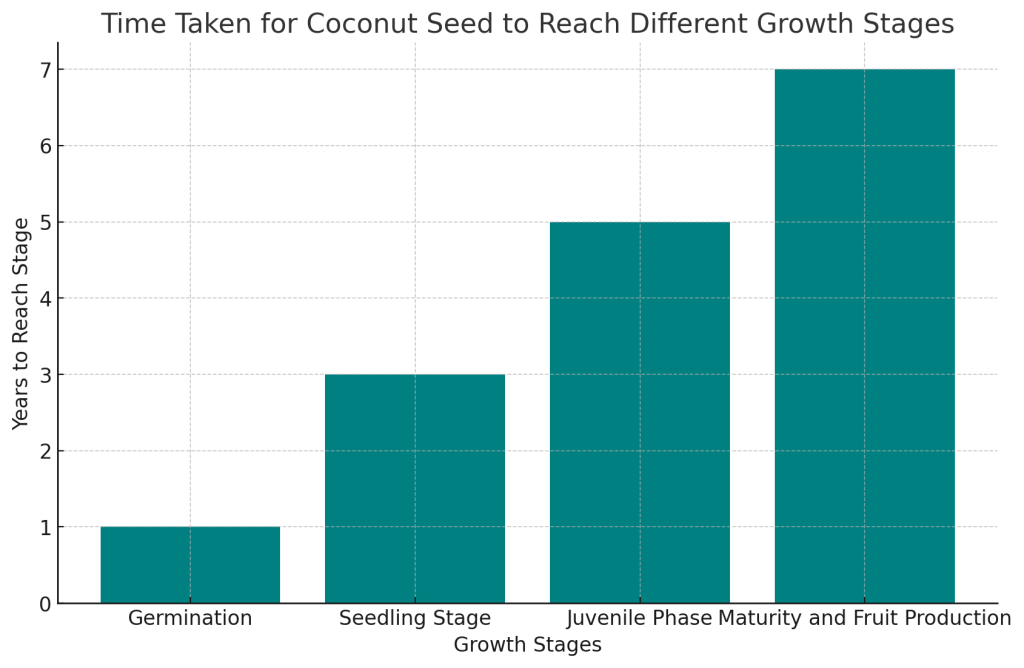Key Takeaways:
| Aspect | Details |
|---|---|
| Nature of Coconut | Classified as a dry drupe |
| External Appearance | Thick, fibrous husk; hard shell |
| Internal Structure | Contains a single seed with embryo and endosperm |
| Color and Size | Deep, reddish purple; size and shape of a plum |
| Germination | Emergence of shoot from one of the seed’s pores |
The Mystique of Coconut Seeds
Coconuts, the marvels of tropical regions, are not only a staple in various cuisines but also a subject of botanical interest. When delving into what a coconut seed looks like, we uncover a fascinating world of plant biology and the unique characteristics that make coconuts so distinct.
The Nature of a Coconut Seed
Contrary to popular belief, the term “coconut” refers to the entire fruit, which is technically a dry drupe. This classification is significant because it emphasizes the coconut’s unique structure, comprising three layers. The outermost layer, which is hard and can be either green or brown when ripe, is often removed before coconuts reach the market.
External Features of the Coconut Seed
When you look closely at a coconut seed, it’s a study in contrasts. On the outside, it is encased in a thick, fibrous husk, which is an integral part of the fruit’s protective mechanism. Within this husk is a hard shell, which encloses the actual seed.
The Intricacies Inside
The coconut seed is not just a static entity; it’s a hive of potential life. Deep, reddish purple in color, and resembling a plum in size and shape, each coconut seed harbors an embryo root (hypocotyl) and embryo leaves (epicotyl). These parts are crucial for the seed’s germination, eventually leading to the development of a new coconut tree.
Germination: The Start of a New Life
Coconut seeds possess an intriguing feature: three pores, often referred to as “eyes”. It is through one of these pores that the seed germinates, marking the start of a new plant’s life. Accompanying the embryo within the seed is the endosperm, which serves as the initial food source for the emerging plant.
Beyond the Seed: A Glimpse into the Coconut World
To further your understanding of coconuts, explore our detailed articles about the appearance of a coconut tree and the visual aspects of cream of coconut. These will provide a broader perspective on the various facets of this remarkable fruit.

The Lifecycle of a Coconut Seed: From Germination to Tree
Understanding the lifecycle of a coconut seed is crucial in appreciating how this unique plant contributes to ecosystems and human use. Let’s delve into the stages of a coconut’s journey from a seed to a fully grown tree.
Stages of Growth and Development
- Germination: The process begins when the coconut seed germinates. One of the three eyes, or pores, of the coconut serves as the starting point for the emerging shoot. This marks the first step towards the coconut’s transition from a seed to a tree.
- Seedling Stage: After germination, the coconut enters the seedling stage, where it starts to develop roots and leaves. This is a critical phase, as the young plant is vulnerable and requires optimal conditions to grow.
- Juvenile Phase: As the plant continues to grow, it enters the juvenile phase. During this stage, the coconut plant begins to establish itself more firmly, developing a stronger root system and more robust leaves.
- Maturity and Fruit Production: Eventually, the coconut tree reaches maturity. It’s at this stage that it starts producing fruits – the coconuts. The time it takes for a coconut tree to start bearing fruit can vary, but it generally takes several years from the seed stage.
Factors Influencing Growth
- Soil Quality: Coconut trees thrive in sandy, well-drained soils. Soil quality significantly impacts the growth rate and overall health of the tree.
- Climate: Being a tropical plant, coconuts require a warm climate with adequate rainfall. Extreme temperatures or water scarcity can adversely affect their growth.
- Care and Maintenance: Regular watering, proper fertilization, and protection from pests and diseases are essential for the healthy growth of coconut trees.
The Impact of Coconuts on Local Ecosystems and Economies
Coconuts not only serve as a source of food and various products for humans but also play a significant role in local ecosystems. They provide habitat and food for various wildlife species and contribute to soil health. Economically, coconuts are a staple in many tropical regions, supporting local industries such as agriculture, tourism, and crafts.
Conclusion
The coconut seed, with its unique characteristics and vital role in the life cycle of the coconut tree, is a testament to the intricate designs of nature. Its journey from a seed to a towering tree is a remarkable process, highlighting the wonders of plant biology and the diverse ways in which life manifests itself.

